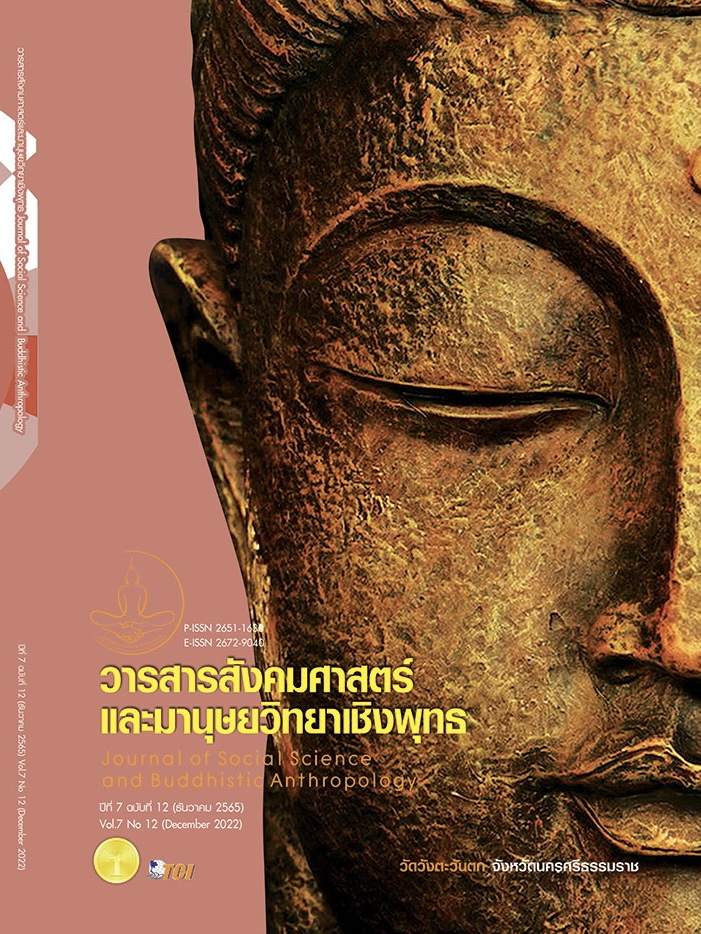STRATEGIES FOR DEVELOPING BUDDHIST TOURISM ACTIVITIES AND ROUTES DVARAVATI ERA IN NAKHON PATHOM PROVINCE
Keywords:
Strategy, Activity Development, Buddhist Tourism Route, Dvaravati Era, Nakhon Pathom ProvinceAbstract
The objectives of this research article were 1) to study the potential and routes of Buddhist tourism, 2) to develop Buddhist tourism activities, 3) to formulate strategies for developing Buddhist tourism activities and routes. This research is a qualitative research, by in-depth interviews with 21 key informants and a specific group discussion of 10 person. Data were analyzed using contextual content analysis techniques. The results of the research were as follows: 1) Potential and Path of Buddhist Tourism 1.1) Potential and Path of Buddhist Tourism 1.1.1) History of Buddhism in the Dharawadee Era 1.1.2) Tourism Conditions Nakhon Pathom Province has an outstanding area in terms of natural tourism resources. History and way of life 1.1.3) Management of tourism activities 1.1.4) Impacts arising from activities and Buddhist tourism routes 1.2) Strategies for developing activities and Buddhist tourism routes 1.2.1) Strategies for developing activities and Buddhist tourism routes Buddhism 1.2.2) development of activities and Buddhist tourism routes as a policy and strategy for Buddhist tourism 1.2.3) implementation of strategies for developing activities and Buddhist tourism routes 2) Developing activities and defining tourism routes strategies Buddhist tourism, namely: 2.1) potential patterns and paths of Buddhist tourism Dvaravati Era in Nakhon Pathom Province 2.2) Model of Buddhist tourism activities Dvaravati Era in Nakhon Pathom Province 2.3) Strategies for developing activities and Buddhist tourism routes Dvaravati Era in Nakhon Pathom Province.
References
กฤษดา ขุ่นอาภัย. (2552). การท่องเที่ยวเชิงวัฒนธรรม: กรณีศึกษาบ้านลวงเหนือ ตำบลลวงเหนืออำเภอดอยสะเก็ด จังหวัดเชียงใหม่. ใน วิทยานิพนธ์ศิลปศาสตรมหาบัณฑิต สาขาวิชาเศรษฐศาสตร์การเมือง. มหาวิทยาลัยเชียงใหม่.
กลุ่มสารสนเทศเศรษฐกิจการท่องเที่ยงและกีฬา. (2559). การท่องเที่ยวเชิงศาสนา. ใน รายงานภาวะเศรษฐกิจท่องเที่ยว (หน้า 47-48). กรุงเทพมหานคร: สำนักงานปลัดกระทรวงการท่องเที่ยวและกีฬา.
การท่องเที่ยวแห่งประเทศไทย. (2548). แหล่งท่องเที่ยวเชิงเกษตรกรรมพร้อมบริการ. กรุงเทพมหานคร: กองอนุรักษ์การท่องเที่ยวแห่งประเทศไทย.
ธนิต บุตรทิพย์สกุล. (2558). แนวทางการจัดการการท่องเที่ยวเชิงพุทธศาสนา วัดในพื้นที่ฝั่งธนบุรี. วารสารวิทยาการจัดการปริทัศน์, 21(2), 203-210.
พยอม ธรรมบุตร. (2546). หลักการท่องเที่ยวเชิงอนุรักษ์. กรุงเทพมหานคร: มหาวิทยาลัยศรีนครินทรวิโรฒ.
พรทิพย์ กิจเจริญไพศาล. (2553). การศึกษาทรัพยากรท่องเที่ยวเชิงวัฒนธรรมของชุมชนชาวมอญเพื่อส่งเสริมการท่องเที่ยวเชิงนิเวศในจังหวัดปทุมธานี. ใน วิทยานิพนธ์วิทยาศาสตรมหาบัณฑิต สาขาวิชาการวางแผนและการจัดการการท่องเที่ยวเพื่ออนุรักษ์สิ่งแวดล้อม. มหาวิทยาลัยเกษตร.
มูลนิธิโครงการสารานุกรมไทยสำหรับเยาวชนฯ. (2557). สารานุกรมไทยสำหรับเยาวชน เล่มที่ 20 ศาสนาและความเชื่อ. กรุงเทพมหานคร: โครงการสารานุกรมไทยสำหรับเยาวชน โดยพระราชประสงค์ในพระบาทสมเด็จพระเจ้าอยู่หัว.
รุ่งโรจน์ ธรรมรุ่งเรือง. (2562). พระพุทธรูปและพระพิมพ์ทวารวดีภาคตะวันออกเฉียงเหนือ. ใน ดุษฎีนิพนธ์ปรัชญาดุษฎีบัณฑิต สาขาวิชาประวัติศาสตร์ศิลปะไทย. มหาวิทยาลัยศิลปากร.
David, F. R. (2007). Strategic management: Concepts and cases. Upper Saddle River, NJ: Pearson Prentice Hall.
Downloads
Published
How to Cite
Issue
Section
License
Copyright (c) 2022 Journal of Social Science and Buddhistic Anthropology

This work is licensed under a Creative Commons Attribution-NonCommercial-NoDerivatives 4.0 International License.








